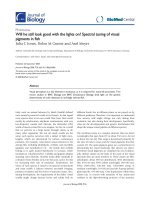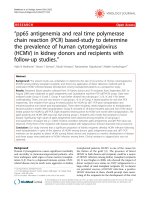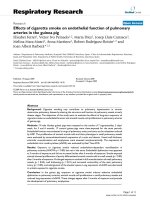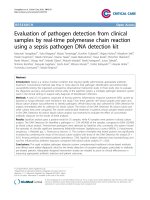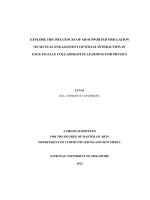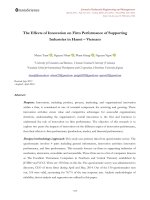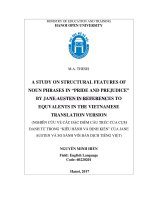Researh on the capability of epigallocatechin gallate in protecting the cells against ionization radiation by using the polymerase chain reaction (PCR)
Bạn đang xem bản rút gọn của tài liệu. Xem và tải ngay bản đầy đủ của tài liệu tại đây (927.03 KB, 4 trang )
Tiểu ban D3-D4: Ứng dụng kỹ thuật hạt nhân trong nông nghiệp, ứng dụng công nghệ bức xạ
Section D3-D4: Application of nuclear techniques in agriculture, radiation technology application
NGHIÊN CỨU KHẢ NĂNG BẢO VỆ TẾ BÀO KHỎI CÁC BỨC XẠ ION HÓA CỦA
EPIGALLOCATECHIN GALLATE BẰNG PHẢN ỨNG CHUỖI POLYMERASE (PCR)
RESEARH ON THE CAPABILITY OF EPIGALLOCATECHIN GALLATE IN PROTECTING THE CELLS
AGAINST IONIZATION RADIATION BY USING THE POLYMERASE CHAIN REACTION (PCR)
TRAN THI NHAN(1*), YOUICHIROU MATUO(2), VUONG THU BAC(3),
DANG DUC NHAN(3), YOSHINOBU IZUMI(2)
Electric Power University (EPU), 237 Hoang Quoc Viet, Bac TuLiem District, Ha Noi, Vietnam
(2)
Research Institute of Nuclear Engineering, University of Fukui,
1 Chome-3-33 Kanawacho, Tsuruga, Fukui 914-0055, Japan.
(3)
Institue for Nuclear Sciences and Technologies (INST), Vietnam Atomic Energy Institute,
179 Hoang Quoc Viet st., CauGiay District, Ha Noi, Vietnam
Address of contact person: Tran Thi Nhan, Cell phone:0386686752; Email:
Tóm tắt: Mục đích của nghiên cứu này là đánh giá khả năng bảo vệ tế bào của epigallocatechin gallate (EGCG) chiết xuất
từ chè xanh khỏi những ảnh hưởng của bức xạ ion hóa. Để đạt mục tiêu đề ra nghiên cứu đã tiến hành thực nghiệm như sau.
Tế bào nấm men đã được nuôi cấy trong môi trường YDP lỏng chứa chiết xuất nấm men, peptone và dextrose/glucose với
sự có và khơng có EGCG, rồi chiếu xạ bằng tia X và tia gamma với liều xạ 50 và 100 Gy. Ribonucleic acid (RNA)
polymerase, enzyme xúc tác cho phản ứng tổng hợp RNA thông tin (mRNA) từ khuôn DNA, được chiết xuất từ các tế bào
nấm men chiếu xạ. Phản ứng chuỗi polymerase (PCR) được áp dụng để tạo ra sự khuếch đại ngẫu nhiên RNA polymerase
của các mẫu chiếu xạ. Sử dụng kỹ thuật PCR, chúng tôi nhận thấy RNA thông tin cho việc tổng hợp protein từ DNA tổn
thương đứt gẫy sợi đơn do chiếu xạ tia X và tia gamma với liều 50 kGy đã giảm từ 1,01 và 1,17 lần xuống 0,72 lần và 0,57
lần khi bổ sung 500µM EGCG. Đối với các tế bào bị chiếu xạ với liều 100Gy, đại lượng này giảm từ 1,07 và 1,90 lần
xuống 0,79 lần và 0,52 lần, tương ứng. Kết quả của chúng tôi chứng tỏ rằng EGCG đã có hiệu quả trong việc bảo vệ chống
lại tổn thương sợi đơn trên DNA gây bởi bức xạ ion hóa.
Abstract: The aim of this study was to investigate into the capability of epigallocatechin gallate (EGCG) extracted from
green tea in protecting the cells from ionization radiation. For this purpose, yeast cells were cultured in YDP broth, a liquid
medium containing yeast extract, peptone, and dextrose/glucose in the presence and absence of EGCG, then irradiated by
X-rays and gamma rays at doses of 50 and 100 Gy. Ribonucleic acid (RNA) polymerase, an enzyme responsible for
synthesizes messenger RNA molecules (mRNA) from a template of DNA, were extracted from the irradiated samples.
Polymerase chain reaction (PCR) was applied to make a random amplification of the RNA polymerase of the irradiated
cells. Using the quantitative real time PCR technique, we found mRNA synthesized from DNA single-strand breaks (SSB)
of the cells iradiated by X- and gamma rays at 50Gy was down-regulated from 1,01 and 1,17 times to 0.72 and 0,57 times
in the presence of 500µM EGCG. For the cells irradiated at 100Gy, these values decreased from 1,07 and 1.90 times to
0.79 and 0.52 times, respectively. Our results suggested that EGCG is an effective agent for providing good protection
against the SSB of ionizing radiation.
Keywords: Yeast cell, radiation protection, free radical, EGCG, PCR.
1. INTRODUCTION
Ionizing radiation comes from the decay process of unstable nuclei or by de-excitation of atoms and
their nuclei in nuclear reactors, X-ray machines, cyclotrons, and other devices. It is well known that
ionizing irradiation can cause the structural and functional changes leads to cell damage or even cell death.
In general, ionizing radiation induce to form free radicals, which attack to biological macromolecules such
as DNA, proteins, lipids and other molecules in the cell. As generic material, DNA molecules are the
critical targets of radiation, and irradiation may cause serious damages in the DNA molecules, leading to
mutation or even cell death. Radiation also causes a wide range of lesions in DNA such as single strand
breaks (SSB) in the phosphodiester linkage, double strand breaks (DSB) on opposing sites or displaced,
base damage, protein-DNA crosslinks, and protein-protein [1, 2, 3]. There are two interaction mechanisms
of ionizing radiation on DNA. One involves ionization of atoms in the DNA (direct effect), while the other
involves the attacks by free radicals produced by the radiolysis of surrounding water molecules (indirect
effect) [1].
Epigallocatechin 3-Gallate (EGCG) is a major component of green tea and is an ester of
epigallocatechin and gallic acid, which belong to polyphenol and catechin groups. The beneficial effect of
EGCG has been reported in many liver disease models in animals such as ischemia/reperfusion injury, fatty
534
Tuyển tập báo cáo Hội nghị Khoa học và Công nghệ hạt nhân toàn quốc lần thứ 14
Proceedings of Vietnam conference on nuclear science and technology VINANST-14
liver, alcoholic liver damage and cancer [4,5]. EGCG, together with other green tea polyphenols also exhibits
growth inhibitory properties in a variety of tumour cell lines [6]. Several mechanisms have been proposed
by which these compounds exert their anti-tumorigenic action: these include the blockade of growth factors
binding to their receptors10, phosphorylation (activation) of mitogen-activated protein kinases (MAPKs)[7, 8]
possibly resulting in the observed induction of Phase II drug-metabolizing enzymes[9, 10], and the generation
of oxidative stress leading to apoptosis7,9.
The advent of the polymerase chain reaction (PCR) radically transformed biological science from the
time was first discovered by Mullis[3]. PCR is a simple and widely used process in which minute amounts
of DNA can be amplified into multiple copies. In addition to the rapidity with which this assay works, it
can quantitatively demonstrate how much of a particular sequence is present [3,4]. Messenger ribonucleic
acid (mRNA) is a single-stranded molecule of RNA that corresponds to the genetic sequence of a gene and
is read by a ribosome in the process of synthesizing a protein. The PCR mehtod was also used in screening
for deletion mutations in the hprt gene by Aghamohammadi el al.[11].
In this study, we investigated the protection of EGCG for DNA single strand breaks in irradiated
cells using primers for amplification of RNA polymerase, an enzyme responsible to synthesis of mRNA
from the damaged DNA, through its down-regulated capacity.
2. MATERIALS AND METHODS
2.1. Samples preparation
Yeast cells from Takara Bio Company (Shinga, Japan) were cultured in yeast extract-peptonedextrose (YPD) media with or without EGCG (500 μM), which was added in 5 ml YPD culture broth for
cells growing. Cells were cultured for 24 h at 30 °C with shaking. Saturated cultures were used to inoculate
fresh media, and the new cultures were incubated for a further 3 h at 30 °C to reach exponential phase (2 −
3 × 107cells/ml) prior to initiating experiments. EGCG was purchased from Nacalai Tesque, Inc, Japan
with a purity ≥ 99.5%.
2.2. Irradiation
In this study two experiments were conducted separately with X-ray and gamma-ray irradiation. The
X-ray irradation was carried out on a LINAC of the Research Institute of Nuclear Engineering (University
of Fukui, Japan) with the yeast samples at a total dose of 0, 50 and 100 Gy and dose rate of 15 kGy/h. The
gamma-ray irradiation was conducted with the same dose (50 and 100 Gy) but at a lower dose rate (5
kGy/h) of 60Co source of the Radiation Laboratory of the Institute of Scientific and Industrial Research
(ISIR, Osaka University, Japan).
2.3. Gene expression
Total cellular RNA was purified using the RNeasy Mini Kit (Qiagen, Valencia, CA). Two
micrograms of RNA were reverse-transcribed using the Superscript First Strand synthesis system for
conversion to cDNA (Invitrogen, Carlsbad, CA). An aliquot from this reaction was used as the template for
PCR amplification with Rad4 primer. Rad4 primer is a DNA damage (Single strand break) recognition
protein essential for global genomic nucleotide excision repair in Saccharomyces cerevisiae. The structures
of the primer were shown in Table 1.
Table 1. Structures of Rad4 primer [4]
Gene name
Primer sequences
Rad4 forward primer
CGATGCTCAGGGCTTGTAATG
Rad4-reverse primer
TTGGTAAAATCTGGCGGTTGA
PCR amplification was performed in a 50 μL reaction mixture. The mixture consisted of 25 μL
Standard Taq Reaction Buffer, 2 μL primer (15 pmol), 1μL RNA, and 22 μL water. The amplifications
were carried out by using a thermal cycler programmed at 42 oC for 30 min, 95 0C for 5 min, followed by
50 cycles of 95 oC for 10 s, 60 oC for 30 s, and 72 0C for 30 s, a final extension step at 72 oC for 10 s and
535
Tiểu ban D3-D4: Ứng dụng kỹ thuật hạt nhân trong nông nghiệp, ứng dụng công nghệ bức xạ
Section D3-D4: Application of nuclear techniques in agriculture, radiation technology application
stored at 10oC.
Fold change is a measure describing how much a quantity changes between an original and
subsequent measurement. Messenger ribonucleic acid (mRNA) is a single-stranded molecule of RNA that
corresponds to the genetic sequence of a gene and is read by a ribosome in the process of synthesizing a
protein[5]. The mRNA fold change was determined by the formula below:
mRNA fold change =
Number of experimental gene
(1)
Number of a control gene
3. RESULTS
The mRNA fold change of DNA irradiated by X-rays in the presence and absence of EGCG was
presented in Fig.1.
Rad 4-SSB
1.5
mRNA Fold change
Without EGCG
500µM EGCG
1
0.5
0
0
50
X- rays absorbed dose (Gy)
100
Figure 1. The mRNA fold change of DNA in yeasts irradiated by X-rays in the presence and absence of 500µM EGCG
As seen from Figure 1 that EGCG can protect DNA from damage caused by ionizing radiation. The
DNA damage was clearly reduced in the presence of EGCG. At 50 Gy of X-rays irradiation and in the
presence of 500 µM EGCG, mRNA fold change decreases from 1,01 times to 0.72 times. This number also
decreased from 1,07 times to 0.79 times at 100 Gy of X-rays irradiation and in the presence of 500 M
EGCG. The results clearly demonstrated that the number of single strand breaks in DNA was reduced in
the presence of 500 µM EGCG.
mRNA Fold Change
2.5
2
1.5
Rad4 -SSB
Without EGCG
500µM EGCG
1
0.5
0
0
50
Gamma absorbed dose (Gy)
100
Figure 2. The mRNA fold change of DNA `in yeasts irradiated by gamma-rays in the presence and absence of
500µM EGCG
The protective role of EGCG for DNA from inonizing radiation is clearer at higher LET. For the
gamma irradiation, mRNA fold change decreased from 1,17 times to 0.57 times in the presence of 500 µM
536
Tuyển tập báo cáo Hội nghị Khoa học và Công nghệ hạt nhân toàn quốc lần thứ 14
Proceedings of Vietnam conference on nuclear science and technology VINANST-14
EGCG at 50 Gy absorbed dose and it decreased from 1,09 times to 0.51 times at 100 Gy (Fig. 2).
Results of X-rays and gamma-ray irradiations showed that in the presence of EGCG the number of
fold changes in mRNA was lower than that number in the control. This means that in the presence of 500
M EGCG the number of single strand breaks in DNA is smaller than in the case without the reagent.
4. DISCUSSION
The EGCG acts as an agent that can inhibit the molecular damage caused by ionizing radiation.
Bioflavonoids which contain EGCG have a protective effect on the DNA damage induced by the hydroxyl
radicals. One of the mechanisms that explain the protective effect of flavonoids on the DNA is the
involvement of chelating metal ions, such as copper or iron (Fenton reaction). The flavonoids complexed
with the copper or iron prevent the generation of reactive intermediate species, known to protect DNA from
oxidative damage resulting from the attack of •OH, H2O2, and •O2 – on the DNA oligonucleotides. The
radical scavenging effect of EGCG on DNA is due to dual activities: reactive intermediate scavenging
activity, and reducing power ion in the Fenton reaction [6,7]. The flavonoids complexed with the copper or
iron prevent the generation of the ROS. In the Fenton reaction system, Fe2+ reacts with H2O2 and oxidized
to Fe3+ and produce the hydroxyl radical, which lead to the DNA damage. EGCG exhibited a great
reducing power on iron ions, especially at high concentrations. The radical scavenging effect of EGCG on
DNA cause due to dual activities: ROS Scavenging activity, and reducing power ion in Fenton reaction [5].
In the low concentration, EGCG protects DNA against oxidative damage and with the increase of
concentration, EGCG reducing power on the iron ion, which accelerates the generation of hydroxyl radical
from the Fenton reaction, it may gradually predominant over radical scavenging ability which effect on
DNA damage.
5. REFERENCES
[1] Radiation Biology: A Handbook for Teachers and Students, TCS (Training Course Series), No. 42 (2010), International Atomic Energy Agency, Vienna.
[2] BEIR V (Biological Effects of Ionizing Radiation, V) (1990) Health Effects of Exposure to Low Levels of Ionizing
Radiation,; Washington (DC): National Academies Press (US), 1990 ISBN-10: 0-309-03997-5;
[3] Eric Hall (1994). Radiobiology for the Radiologist, 4th ed. (Philadelphia: J. B. Lippincott, 1994), 3.
[4] Cheng Chen, Qian Liu, Lin Liu, Yi-yang Hu, and Qin Feng (2018). Potential Biological Effects of Epigallocatechin-3gallate on the Treatment of Nonalcoholic Fatty Liver Disease Mol. Nutr. Food Res. 2018, 62, DOI:
10.1002/mnfr.201700483;
[5] Ryuchiro Sakata, Takato Ueno, Toru Nakamura, Masaharu Sakamoto, Takuji Torimura, Michio Sata (2004) Green tea
polyphenol epigallocatechin-3-gallate inhibits platelet-derived growth factor-induced proliferation of human hepatic
stellate cell line LI90, Journal of Hepatology 40(1): 52-59.
[6] Yang GY, Liao J, Kim K, Yurkow EJ, Yang CS (1998) Inhibition of growth and induction of apoptosis in human cancer cell lines by tea polyphenols. Carcinogenesis 19:611–616.
[7] Yang GY, Liao J, Li C, Chung J, Yurkow EJ, Ho CT, Yang CS (2000) Effect of black and green tea polyphenols on
c-jun phosphorylation and H2O2 production in transformed and non-transformed human bronchial cell lines: possible
mechanisms of cell growth inhibition and apoptosis induction. Carcinogenesis 21:2035–2039.
[8] Liang YC, Lin-Shiau SY, Chen CF, Lin JK (1997) Suppression of extracellular signals and cell proliferation through
EGF receptor binding by ()-epigallocatechin gallate in human A431 epidermoid carcinoma cells. J Cell Biochem
67:55–65.
[9] Chen C, Yu R, Owuor ED, Kong AN (2000) Activation of antioxidant response element (ARE), mitogen-activated
protein kinases (MAPKs) and caspases by major green tea polyphenol components during cell survival and death.
Arch Pharm Res 23:605–612.
[10] Kong AN, Yu R, Chen C, Mandlekar S, Primiano T (2000) Signal transduction events elicited by natural products:
role of MAPK and caspase pathways in homeostatic response and induction of apoptosis. Arch Pharm Res 23:1–16
[11] Aghamohammadi SZ, David TM, Thacker LSJ (1992) Rapid screening for deletion mutations in the hprt gene under
X-ray and -irradiation using the polymerase chain reaction: X-ray and α-particle mutant spectra. Mutation
Research/Fundamental and Molecular Mechanisms of Mutagenesis, 269(1): 1-7.
537
